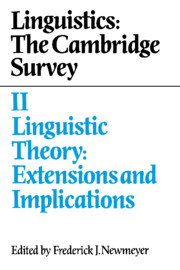Book contents
- Frontmatter
- Contents
- Contributors
- Preface
- 1 Extensions and implications of linguistic theory: an overview
- 2 Grammar and language processing
- 3 Grammatical principles of first language acquisition: theory and evidence
- 4 Second language acquisition and grammatical theory
- 5 Brain structures and linguistic capacity
- 6 Abnormal language acquisition and the modularity of language
- 7 Grammatical aspects of speech errors
- 8 Grammar and conversational principles
- 9 Discourse analysis: a part of the study of linguistic competence
- 10 Speech act distinctions in grammar
- 11 Computer applications of linguistic theory
- 12 Metrics and phonological theory
- 13 Grammatical theory and signed languages
- 14 The linguistic status of creole languages: two perspectives
- 14.I Creole languages and the bioprogram
- 14.II Are creoles a special type of language?
- 14.III A dialog concerning the linguistic status of creole languages
- Subject index
- Name index
- Contents of volumes I, III, and IV
12 - Metrics and phonological theory
Published online by Cambridge University Press: 08 February 2010
- Frontmatter
- Contents
- Contributors
- Preface
- 1 Extensions and implications of linguistic theory: an overview
- 2 Grammar and language processing
- 3 Grammatical principles of first language acquisition: theory and evidence
- 4 Second language acquisition and grammatical theory
- 5 Brain structures and linguistic capacity
- 6 Abnormal language acquisition and the modularity of language
- 7 Grammatical aspects of speech errors
- 8 Grammar and conversational principles
- 9 Discourse analysis: a part of the study of linguistic competence
- 10 Speech act distinctions in grammar
- 11 Computer applications of linguistic theory
- 12 Metrics and phonological theory
- 13 Grammatical theory and signed languages
- 14 The linguistic status of creole languages: two perspectives
- 14.I Creole languages and the bioprogram
- 14.II Are creoles a special type of language?
- 14.III A dialog concerning the linguistic status of creole languages
- Subject index
- Name index
- Contents of volumes I, III, and IV
Summary
Background
The field of metrics studies how conventionalized rhythmic patterns are manifested by phonological material in verse. Metrics and phonology are closely related fields whose interaction is yielding increasingly important results. This chapter outlines some of these findings, as well as directions for future research.
First, a caveat concerning what this chapter is not about. Metrics is only part of the larger field of poetics, which studies literature from the structural viewpoint adopted in linguistics. Excellent introductions to poetics may be found in Jakobson (1960) and Kiparsky (1973). I will also bypass work on metrics that is not focussed on the link to linguistic structure and to phonology in particular. The annotated bibliography of Brogan (1980) is recommended as a guide to such work.
A good place to start is to establish what questions linguists should try to answer in studying metrics; this defines the basic research strategy. To my mind the most compelling proposal has been the ‘generative metrics’ originated in the 1960s by Halle and Keyser (cf. Halle & Keyser 1969; Keyser 1969; and especially Halle & Keyser 1971). Generative metrics focusses on the problem of well-formedness. We assume that a meter is an abstract rhythmic form, internalized by those who command the relevant metrical tradition. Participants in a tradition share a tacit set of rules which determine which phonological sequences of their language constitute well-formed instantiations of a meter. Such sequences are termed metrical, while sequences excluded by the rules are termed unmetrical.
- Type
- Chapter
- Information
- Linguistics: The Cambridge Survey , pp. 220 - 249Publisher: Cambridge University PressPrint publication year: 1988
- 12
- Cited by



